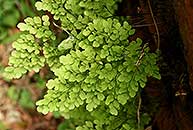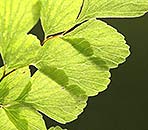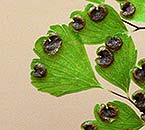Adiantum raddianum C.Presl
Synonyms |
Adiantum cuneatum Langsd. & Fisch. |
|---|---|
Common name |
|
Description |
Rhizome short, creeping, branched; rhizome scales lanceolate, 1.5 mm long, brown, entire. Fronds monomorphic, closely spaced to tufted, erect or arching, thinly herbaceous. Stipe up to 25 cm long, thin, shiny, dark brown to black, glabrous. Lamina 3-4 pinnate, triangular to broadly ovate in outline, 10-25 × 8-15 cm, hairless; pinnules persistent, obtriangular to trapeziform with straight sides, base wedge-shaped, outer margin irregularly incised into rounded lobes with toothed margins, 1.2 × 1 cm; veins ending in the sinuses of the marginal serrations; rhachis and stalks dark brown to black, hairless; stalklets 1-3 mm long. Sori on the outer margins of ultimate segments, indusial flaps broadly overlapping the sori, kidney shaped to circular, c. 1.5 mm in diameter. |
Notes | A. raddianum is 3-4 pinnate. The small persistent pinnules, serrated outer margin with the veins ending in between the serrations and the reniform to almost circular sori distinguish A. raddianum from similar species such as A. poiretii orA. capillus-veneris . |
Derivation | raddianum: named after Guiseppe Raddi (1770-1829), Italian botanist who collected in Brazil from where the type originates. |
Habitat | Shaded moist earthbanks, roadcuttings and streambanks in forest. |
Distribution worldwide | Native to South America, now widely naturalised. |
Distribution in Africa |
Kenya, Malawi, Mozambique, South Africa, Swaziland, Tanzania , Uganda, Zimbabwe. |
Growth form |
Terrestrial. |
Literature |
|



